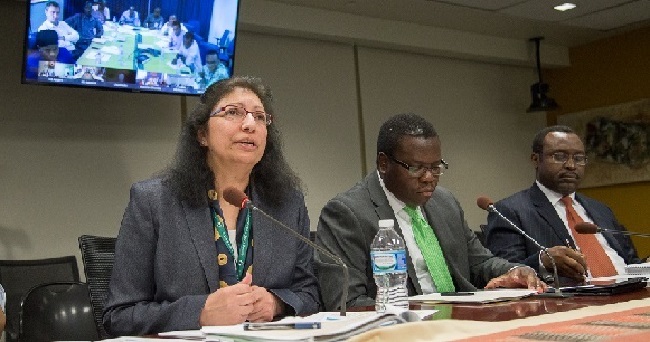Low commodity prices impede African growth

Africa’s Pulse Video Conference. Punam Chuhan-Pole (1st from left), Acting Chief Economist of the World Bank Africa and the report’s author. Photo: Dasan Bobo, World Bank
Economic activity in Sub-Saharan Africa slowed in 2015, with GDP growth averaging 3.0 percent, down from 4.5 percent in 2014. This means that the pace of expansion decelerated to the lows last seen in 2009.
These figures are outlined in Africa’s Pulse, the World Bank’s twice-yearly analysis of economic trends and latest data for the region.
The 2016 growth forecast remains subdued at 3.3 percent, way below the robust 6.8 percent growth in GDP that the region sustained in the 2003-2008 period. Overall, growth is projected to pick up in 2017-2018 to 4.5 percent.
The plunge in commodity prices – particularly oil, which fell 67 percent from June 2014 to December 2015 – and weak global growth, especially in emerging market economies, are behind the region’s lackluster performance.
In several instances, the adverse impact of lower commodity prices was compounded by domestic conditions such as electricity shortages, policy uncertainty, drought and security threats which stymied growth.
There were some bright spots where growth continued to be robust such as in Côte d’Ivoire, which saw a favorable policy environment and rising investment, as well as oil importers such as Kenya, Rwanda, and Tanzania.
The external environment confronting the region is expected to remain difficult. In a number of countries, policy buffers are weaker, constraining these countries’ policy response. Delays in implementing adjustments to the drop in revenues from commodity exports and worsening drought conditions present risks to Africa’s growth prospects.
”As countries adjust to a more challenging global environment, stronger efforts to increase domestic resource mobilization will be needed. With the trend of falling commodity prices, particularly oil and gas, it is time to accelerate all reforms that will unleash the growth potential of Africa and provide affordable electricity for the African people,” says Makhtar Diop, World Bank Vice President for Africa.
Several countries are expected to see moderate growth. Among frontier markets, growth is expected to edge up in Ghana, driven by improving investor sentiment, the launch of new oilfields, and the easing of the electricity crisis. In Kenya, growth is expected to remain robust, supported by private consumption and public infrastructure investment.
The projected pickup in activity in 2017-2018 reflects a gradual improvement in the region’s largest economies – Angola, Nigeria, and South Africa – as commodity prices stabilize and growth-enhancing reforms are implemented.
African Cities as Engines of Growth
As Africa undergoes rapid urban growth, there is a window of opportunity to harness the potential of cities as engines of economic growth.
The rapid decline in oil and commodity prices has adversely affected resource-rich countries and signaled an urgent need for economic diversification in Africa. Urbanization and well managed cities provide a major opportunity to offer a springboard for diversification.
The growth of cities, when well managed, can spur economic growth and productivity. But African cities are currently not delivering agglomeration economies or reaping urban productivity benefits. Instead they suffer from high housing and transport costs, in addition to the high cost of food that takes up a large share of urban household budgets.
Housing and transport are particularly costly in urban Africa. Housing prices are about 55 percent higher in urban areas of African countries relative to their income levels. Urban transport, which includes prices of vehicles and transport services, is about 42 percent more expensive in African cities than cities in other countries.
Like households and workers, firms also face high urban costs. Cross-country analysis confirms that manufacturing firms in African cities pay higher wages in nominal terms than urban firms in other countries at comparable development levels.
To build cities that work—cities that are livable, connected, and affordable, and therefore economically dense—policy makers will need to direct attention toward the deeper structural problems that misallocate land, fragment development, and limit productivity.
“To ensure growth and social development, cities need to become less costly for firms and more appealing to investors,” says Punam Chuhan-Pole, Acting Chief Economist, World Bank Africa and the report’s author. “They must also become kinder to residents, offering services, amenities. All of this will require reforming urban land markets and urban regulations and coordinating early infrastructure investment.”
Terms of trade
Commodity price drops have lowered Africa’s terms of trade in 2016 by an estimated 16 percent, with commodity exporters seeing large terms-of-trade losses. Across the region in 2016, the impact of this shock is expected to lower economic activity by 0.5 percent from the baseline, and to weaken the current account and fiscal balance by about 4 and 2 percentage points below the baseline, respectively.
Moving Forward
Sub-Saharan Africa countries will continue to face low and volatile prices in global commodity markets. Governments must take steps to adjust to a new, lower level of commodity prices, address economic vulnerabilities, and develop new sources of sustainable, inclusive growth. Africa’s growing urban centers offer a springboard for diversification. But they need better institutions for effective planning and coordination that can raise urban economic density and productivity, and spur the region’s transformation.

